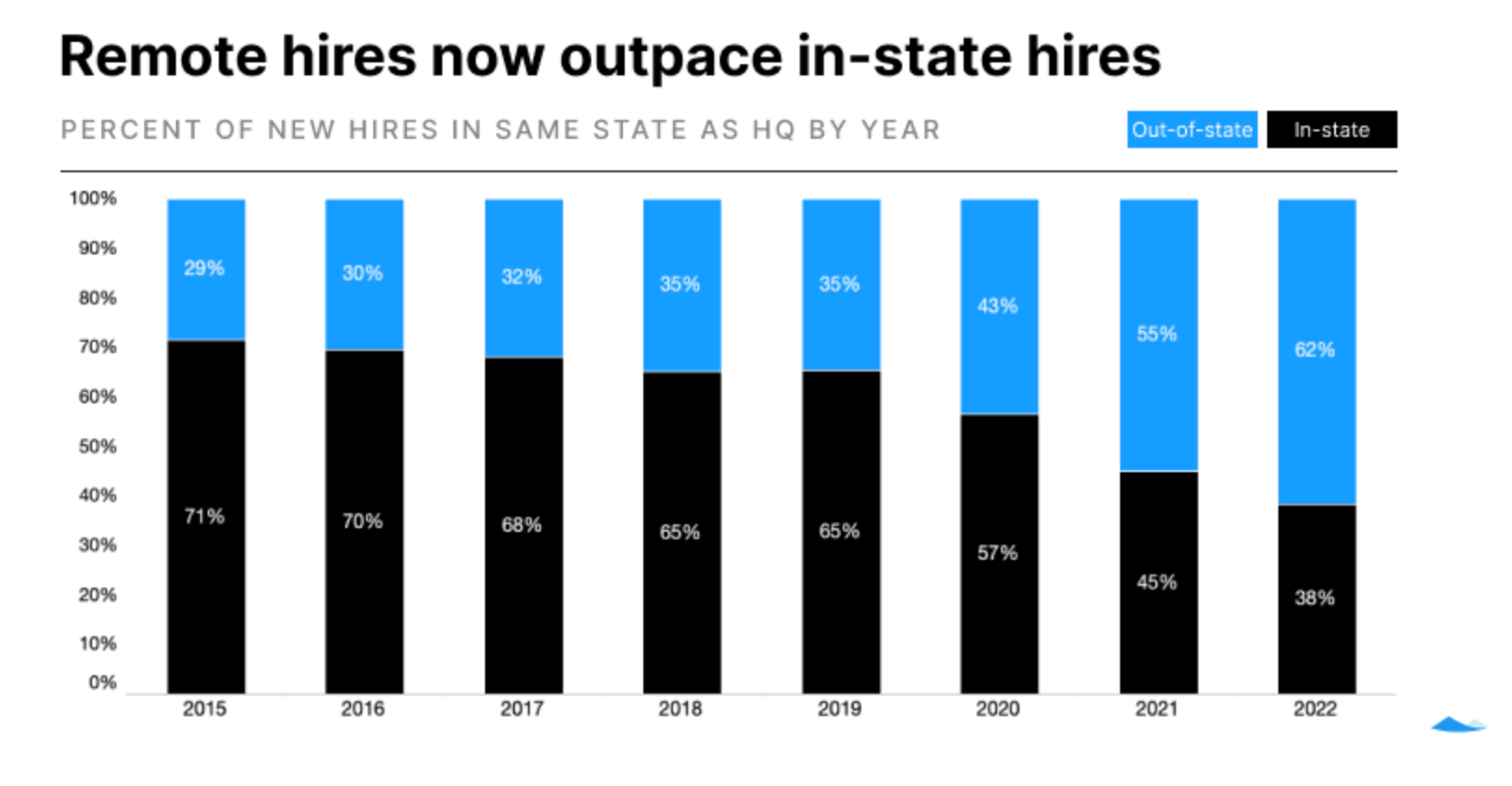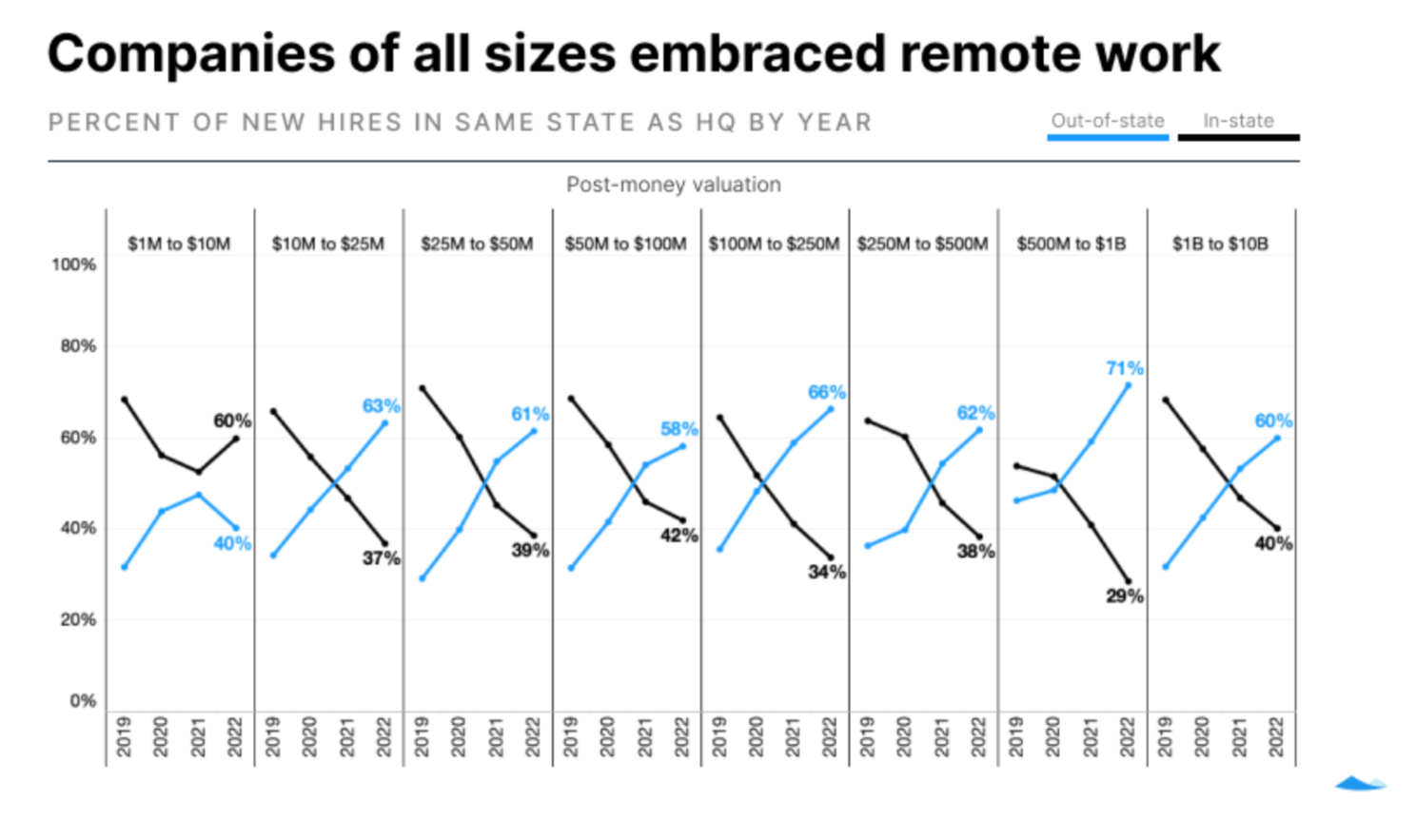If nobody's there, is it still a company?

The office and the corporation are intertwined. A big box full of people and things is the physical embodiment of the legal entity that "owns" these people, their tools, and whatever they produce.
Once people are liberated from the box, what happens to the legal entity?
We focus on how hard it is to manage people who aren't co-located. But that assumes that corporations will remain the same and only the offices will change.
In reality, the remote era will give rise to new corporate structures and ways to coordinate multiple people's activities without "owning" them and the fruits of their labor.
A new report from Carta looks at hiring and compensation trends. The report draw on data from 127,000 employees who use Carta's compensation and salary solutions. It highlights a remarkable trend.

So far in 2022, the percentage of hires that were located in a different state than the primary company headquarters reached 62%, up from 35% in 2019. This means that nearly two-thirds of new employees are not located near the company's main HQ. Some companies have offices in multiple states, but this was also true in 2019. Companies are increasingly willing to "decentralize" their workforce.
This is a rapid intensification of a trend I pointed out in The New York Times:
"In the middle of the 2010s, Amazon, Facebook, Google, Apple, and others started splitting their headquarters into multiple locations. Stripe, one of the world’s most valuable start-ups, went a step further. In 2019, it “opened” a remote hub, hoping to “tap the 99.74 percent of talented engineers living outside the metro areas of our first four hubs” in San Francisco, Seattle, Dublin and Singapore.
For the fastest-growing companies, being able to tap into talent anywhere became more important than having all their teams in one place. Smaller cities were good enough. In retrospect, this shouldn’t have been a surprise, despite all the talk about the importance of giant, dense labor markets to fuel innovation. After all, Silicon Valley itself is not a city but a cluster of sprawling towns scattered along a highway."
Before Covid, this trend was significant but limited to a minority of new hires. Now, it applies to the majority. Also, before Covid, this trend mostly affected giant companies that could afford to open large hubs in multiple cities. But now, it is consistent across companies of all sizes.

Carta's data come mostly from tech companies. Unlike traditional manufacturing firms, tech companies don't open multiple local offices to service local customers. Instead, they are splitting their core R&D activities into multiple locations. This shows that accessing a larger talent pool (by hiring from multiple states) is more important to them than having all their employees in one place.
As Adam Ozimek pointed out, this trend raises questions not just about where employees work but about the whole structure of corporations. This is a question I've explored in my book, long before Covid. In a section titled The Unbundling of the Corporation, I wrote:
"Creative and highly specialized jobs will grow in demand, but they will also grow on demand. Many jobs will not be stable or, more accurately, they will not be jobs at all. Professionals will be called upon to contribute to specific projects and join teams for set periods of time. This will happen both within and outside of corporations.
For a blueprint of how creative or conceptual goods are produced, we can look to the entertainment capital of the world, Hollywood. Film credits include dozens of experts from a variety of disciplines, including finance, law, architecture, design, creative writing, music, material science, computer science, and often even history, criminology, and psychology. These people work together, but they are not 'colleagues' in the traditional sense of the word. They are a group of creative and highly specialized practitioners who were assembled for a set period of time to produce something valuable and unique.
This way of working is increasingly relevant for other industries. As Adam Davison pointed out in the New York Times, '[o]ur economy is in the midst of a grand shift toward the Hollywood model.' The model is being used to build bridges, design mobile apps, launch new restaurants, or develop cosmetic products. Many real estate projects are also developed this way.
In fact, this model has been common throughout human history. The past 150 years have been an exception. Since the late nineteenth century, business has been dominated by large corporations with clear organizational charts. It was an era of mass manufacturing, mass media, and mass retail. A relatively small number of products were marketed using a relatively small number of print, radio, and TV channels, and sold in thousands of near-identical stores. As a result, companies could rely on a relatively stable organizational structure, workforce, and production schedules.
Business in the twenty-first century is very different: A long tail of physical and virtual goods and services are produced by complex networks of suppliers, marketed, and sold across millions of unique digital and physical channels. As sociologist Esko Kilpi pointed out, creative and knowledge-based work requires a mix of capabilities and tasks. This mix is constantly changing and is increasingly difficult to predict. As a result, recruiting is 'becoming a matter of expensive guesswork,' and planning which individuals will perform which tasks is 'getting close to impossible'.
To deal with these challenges, companies are starting to resemble networks or ecosystems, rather than clearly defined entities. "
When we talk about the future of work, it's easy to focus on the most visible changes — where people work. But a much bigger shift is happening underneath the surface. It's a shift that will give rise to new ways to orchestrate, fund, and regulate how people create value together.
I wrote about some of these changes here, here, here, here, and here. And I will continue to explore these themes over the coming months.
Dror Poleg Newsletter
Join the newsletter to receive the latest updates in your inbox.

